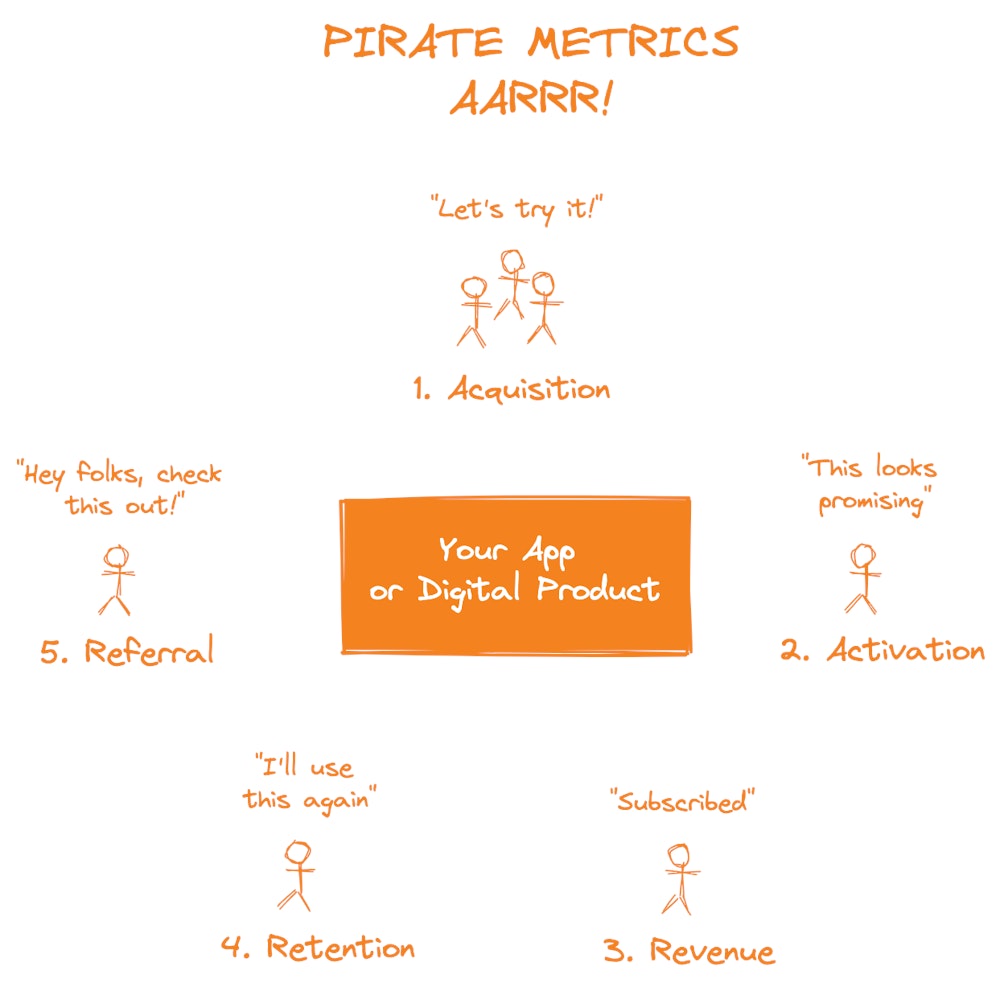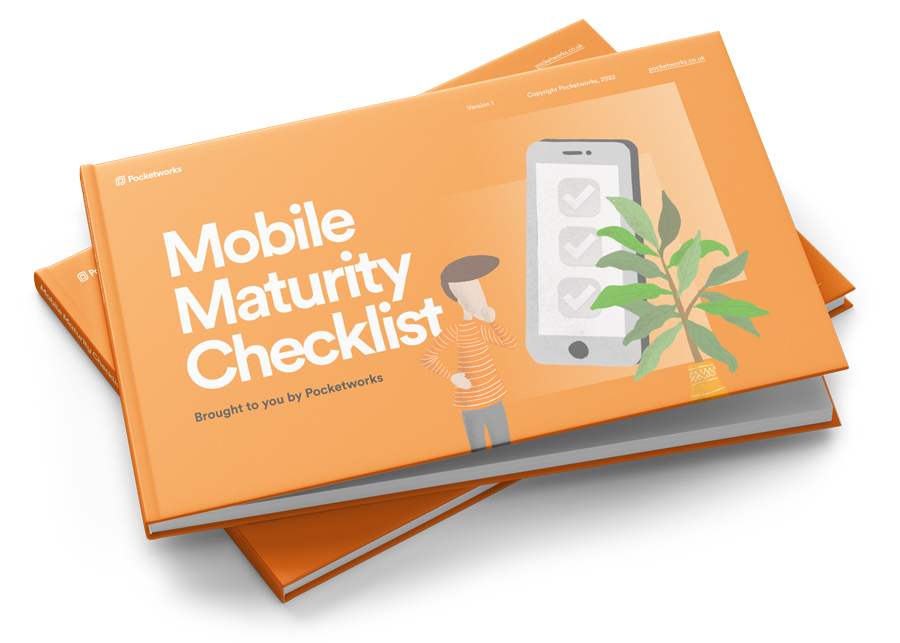Like most app developers, we speak to a fair few startup founders wanting to launch a new app or extend their MVP. Planning a product is hard, and Pirate Metrics can provide loads of value by helping you see your app in a whole new light.
What are Pirate Metrics?
Pirate Metrics are a different and highly useful way of thinking about your app. They're not complicated; they can be represented as a simple bullet-point list. The reason they're so useful is that they encourage you to focus on critical aspects of an app that lead to growth and long-term success.
Let's look at an example.
Say you're a founder who's in the process of developing an app or digital product. You'll probably be pondering a few important things about your fledgling product:
- How will I drive people to my product?
- Will the product have a market fit? Will users "get it"?
- How will the product make money?
- How can we be sure people use the product repeatedly?
- Will users tell other people about the product?
You might have intuitively considered some or all of these angles already. Well, Pirate Metrics is a neat framework that reminds you to look at these important things. In essence, it's a checklist of useful things to think about when planning your product and later improving it.
Here's the actual list of metrics. This is sometimes called AARRR, hence "Pirate" metrics :)
- Acquisition: How will I drive people to my product?
- Activation: How do we know if a user "gets it"?
- Revenue: How will the product make money?
- Retention: How can we be sure people use the product repeatedly?
- Referral: Will users tell other people about the product?
Here's a diagram that might help.

Simple eh? We cover this list in more detail in a free resource to help you grow your mobile app.
When I first heard about Pirate Metrics five years ago, I naively dismissed it. I just didn't get why it was interesting. But a few years later, I learned more about it, practiced using it, and now find it to be an incredibly useful tool.
Note that there are other frameworks too, like Google's HEART, that might also be worth considering.
Why are Pirate Metrics useful?
So why is this framework good? Isn't it just a list of obvious things?
It may seem that way. The thing is, when you start thinking about your app, website, or product from these perspectives, you'll find it really helps you think about the big picture.
You could try it now. Just pick any product you're using and ask yourself how they're achieving Acquisition, Activation, Revenue, Retention and Referral. It's a good way to unpick the strategies of your competitors.
When is the right time to look at Pirate Metrics?
Now you know what Pirate Metrics are, let's look at how you actually apply this to your own practices. The first tip is to pick a junction in your app journey where you are considering what to do next. For example, it might be:
- As you're planning your app or MVP
- As you're about to select the next feature to develop
- As you're looking to analyse what is working or not working on your app
Then you can go through each metric and ask questions like
- Do we have a problem with acquisition?
- Do we understand our retention fully? Which customers are retained the longest?
- How does our revenue generation compare to competitors?
- How many referrals do we get from users? Is it enough?
- Are we happy with our activation levels?
More on this below. The general idea is to ask probing questions about each of the Pirate Metrics and use that to stimulate thoughts and tasks. The key is to ask these questions at the right time; when you're planning what to do next.
Continuously monitoring pirate metrics
Once you start getting to grips with this and realising it's value, you'll find yourself wanting to keep an eye on the answers to some of these questions at all times. For example, you could ask your app team to set up an analytics dashboard that you review daily, weekly, or monthly. This might include things like:
- A pie chart of acquisitions by channel shows where customers are coming from
- A gauge to show 1 day retention, 1 week retention, 30 day retention and yearly retention
- A counter showing how many organic referrals your app has received, where existing users bring new users to your app
- A historical line graph showing the % of customers who are activated (e.g. they didn't just download and abandon the app; instead, they actually got some value from it)
If you're just getting into this stuff, my advice would be to go easy on yourself. Start by asking questions and poking around to find answers. Perhaps add some analytics to reveal answers to data you don't have today. Then, over time, build dashboards. There's no rush on all this stuff, and the 80:20 rule applies; you can get a lot of value from some very top-line numbers. Keep it simple.
Oh, a quick interruption! If you like this article, you'll probably like our newsletter? It brings you loads of useful mobile insights and tips, helping you increase your mobile knowledge every two weeks 👇
Get inspiration from the world of apps.
Righty, now that you've signed up, let's get back to the article 😅
An example when looking at the "Referral" metric
To give a flavour of this, let's look at the 5th AARRR perspective: referral.
Referral mechanisms are pretty fascinating. Referrals aren't just about friend invites, voucher codes, and "share" buttons. They can be so much more. Seth Godin often talks about "sneeze-worthy" products—ones that people are desperate to talk about.
For your own product, consider this:. How can you be sure people will be motivated to talk about your product with other people? After all, this is what drives organic growth. Have you designed your product for this? Have you made it almost effortless to talk about and share?
I'm not talking about a simple social media share button. You see loads of apps that have "share on social media" buttons. But do they really give the user a compelling reason to share? For your product, are any elements people will naturally want to share?
Instagram achieved this because it allowed people to create pro-quality photos without having pro skills. People really wanted to share their creations with friends and family. The product is designed to spread by default. It's not a surprise that Instagram had exponential growth when it launched.
George Berkowski also talks about this in his book, "How to build a billion-dollar app". They really focused on generating referrals for the Hailo taxi app. They wanted everyone who booked a cab to tell their friends about it, so they carefully crafted a referral programme that would encourage that customer behaviour.
And it worked.
Can you do something similar for your product?
How can you use Pirate Metrics?
Each perspective in pirate metrics is important. So how do you use them?
I personally use Pirate Metrics as a reminder to ask relevant questions. It might be during the business planning phase, the product design phase, or the growth phase.
I also find it useful when talking to a founder or CEO about their app ideas during our sales process; it helps me get a grip on the business plan behind an app.
If you're at the planning and design phases, try using the list as a reference to make sure you consider all the important things. It's a lens through which to focus your thinking. You will end up asking yourself questions such as:
Acquisition
- Is there any onboarding that reminds people why the app is useful? We know this helps increase the number of people who stick with it.
- Have we designed an app store landing page that will have a high conversion rate?
- Are we doing app store optimisation to help us attract more customers through organic app store searches?
- Do we expect people to find us on the web? Is there a deep-linking story here?
Activation
- Does our design allow people to "get it" quickly? We don't want them to bounce away before they know what the app is about.
- What is the point where we expect people to have that "ah-ha" moment? Can we record when that happens so we can measure it?
- Have we designed our product to give some kind of instant gratification, where people get value quickly?
Revenue
- What payment options are there for an app?
- Can we use Apple Pay and Google Pay, or is this going to require credit cards with Stripe or something similar?
- Or is this a subscription model, or in-app purchases?
- Have we considered freemium?
- Have we designed screens to convert our non-paying users into paying ones?
Retention
- Have we got the analytics in place so we can measure retention?
- If people leave the app, do we know where or why they are bailing out?
- Do we have any push notification campaigns or email campaigns to bring them back?
Referral
- What do we expect people to share in this app?
- Have we designed any features for their "share appeal"?
- Should we do social media monitoring to see how much people talk about us?
- Should we reward people for sharing the product?
And so on...
If you already have a product out there, Pirate Metrics is useful too. You want to be sure you're measuring AARRR and looking for ways to improve. Pirate Metrics are a great starting point to ask "how is this product performing against all these important criteria?". Analytics and metrics are a big topic, but in a future post, I'll share what we've learned about capturing the important data and using it to optimise your app or digital product.
The key takeaway from all this is - think about how Acquisition, Activation, Revenue, Retention and Referral relate to your product. It's a reliable way to ask sensible questions about how your app is performing, or will perform. And you can use it to check if you've designed a product that can grow.
Hope this was useful! If you'd like to learn more, check out our free resource Turbo-Charge Your App Growth. In the guide, we cover pirate metrics and give you actionable insights on assessing app health, mastering metrics, and cultivating a growth mindset.
Making apps that make a difference
In case you're wondering, Pocketworks is a software consultancy that specialises in mobile apps.
We bring you expertise in user research, mobile technology and app growth tactics to help you develop apps that create positive impact for your customers, shareholders and society.
To get a flavour of us, check out our free guides and app development services. Or, see some more background info on us.


